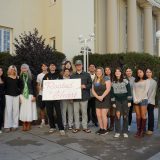Sugar, Spit, and Bay Area Grit
February 19, 2015
Nathan Oliveira was a native California artist (born in Oakland) and since the 1950s has been the subject of thousands of solo and group exhibitions worldwide. He is most commonly associated with the Bay Area Figurative movement, which emerged as a reaction to the Abstract Expressionism of the 1950s and 60s. To this day the movement sparks debate about the nature of representation versus abstraction and the evolution of modernism versus postmodernism in the United States.

Rocker, 2007
Color sugar lift and spit bite aquatint with hard ground etching
ed. 16/35 Published by Crown Point Press, San Francisco
Printer: Iaane Kjorlie
I was first intrigued by the Oliveira pieces (pictured), currently on display in Beckman Hall, when I noted their medium: color sugar lift and spit bite aquatint with hard ground etching. To be completely honest, I had no idea what this meant other than that this was probably some form of printmaking. This area of the third floor of Beckman Hall is also my personal favorite leg of the tour because of the way Oliveira’s figurative pieces are juxtaposed with pieces of contemporary abstraction such as Mary Corse’s Untitled
from 1986. Therefore, I was determined to research these processes.
Sugar lift is a technique that allows the artist to draw a dark form on a white background. The artist draws with sugar syrup, then an aquatint ground is substituted for the syrup before “biting”, when the acid from the aquatint burns into the plate to create the image. Asphaltum, an acid-resistant varnish, is painted thinly over the entire plate including the image in order to protect it from further biting when exposed to acid. After the asphaltum is dry, the plate is put in a bath of warm water until the sugar swells and lifts, leaving the metal exposed in the image area.
Spit bite aquatint is an alternative to bath etching as a way of biting an aquatint. The artist paints a mixture of acid, water, and gum arabic on a plate that is prepared with a rosin ground. The acid bites wherever it touches the plate, showing brushstrokes if the artist so desires. Spit bite aquatint often resembles watercolor painting in the finished print.

Bird, 2007
Color Sugar lift and spit bite aquatint with hard ground etching
ed. 4/35 Published by Crown Point Press, San Francisco
Printer: Iaane Kjorlie
The third method mentioned as part of the artist’s process is hard ground etching, which involves applying beeswax and asphaltum to a heated plate, after which the artist then draws into the plate with a sharp tool. Oliveira’s seemingly simple pieces involve a combination of these three very complex techniques, evidenced in the quality of the final product.
Nathan Oliveira’s compositions are simple and focused with only one recognizable figure taking up the center of the picture plane. Many, including myself, are delighted by his works and thoroughly interested in knowing how he created them. His subject matter, style, and methods contrast the abstraction that was at its height when he made his art world debut and his beautiful work still continues to be unique today.

